The difference between success and failure in Forex / CFD trading is very likely to depend mostly upon which assets you choose to trade each week and in which direction, and not on the exact methods you might use to determine trade entries and exits.
So, when starting the week, it is a good idea to look at the big picture of what is developing in the market as a whole, and how such developments and affected by macro fundamentals, technical factors, and market sentiment. Read on to get my weekly analysis below.
There are a few strong trends in the markets, and following them might help put the odds in your favor, so it is an interesting time to be trading.
Fundamental Analysis & Market Sentiment
I wrote in my previous piece last week that the best trade for the week was likely to be long of USD/JPY or short of GBP/USD, but only in short-term swing or day trades. A better longer-term trade might be the 10-Year and 2-Year US treasury yields. This was a very good, profitable call as all four assets moved in my intended direction over the week:
- USD/JPY rose by 1.07%
- GBP/USD fell by 2.06%
- 10-Year US Treasury Yield rose by 2.05%
- 2-Year US Treasury Yield rose by 2.49%
The news remains dominated by the Russian invasion of Ukraine which is now into its third month. Russian forces have withdrawn from the northern part of the country, switching focus to an offensive aimed at fully capturing the eastern and southern coastal regions of Ukraine. The war initially caused quite strong movements in some markets, especially in some agricultural commodities such as wheat and corn, but now seems to be having a primary effect of depressing the Euro and global stock markets, possibly because the Russian government continues to make oblique nuclear threats. This is hardly news, but analysts are beginning to judge the full impact on the Eurozone more harshly. Of course, there are other fundamental factors weighing on stock markets.
We are currently seeing weakness in stock markets almost everywhere, as well as weakness in European currencies, with the Euro, the British Pound, and the Swiss Franc all reaching long-term lows. The biggest global stock market index, the S&P 500, is looking especially bearish, as it closed the week with accelerating downwards momentum with the 1-year low not far away. This bearishness is being driven by several fundamental and sentimental factors:
- Rising US treasury yields are relatively high, with both the 2-year and 10-year yields ending the week near 3-year highs.
- US Advance GDP data came in lower than expected last week, turning negative for the first time since the coronavirus panic of early 2020, suggesting the US may be suffering from rapidly cooling economic growth, as well as high and rising inflation, placing the Federal Reserve in a very difficult position as it tries to ensure a soft landing for the US economy.
- Inflation continues to a major concern, as G20 economies continue to mostly report new CPI data exceeding consensus forecasts, suggesting that inflation is still accelerating. The release last week of Australian CPI data showing a quarterly increase of 2.2%, well ahead of the 1.7% increase which had been expected, fuels this concern.
The Forex market saw some major price movement over the past week, with the US Dollar gaining strongly as a safe haven and on rebounding yields. The Euro, British Pound, and Swiss Franc lost considerable value, partly due to the impact of the war in Ukraine, partly due to deteriorating economic data. The Japanese Yen lost ground earlier in the week, with the Bank of Japan standing out as the only major central bank still following a dovish monetary policy in its Outlook Report, looking to boost inflation towards its 2% target rate, while everywhere else central banks are trying to stem inflation. However, it should be noted that the Japanese Yen overall ended the week almost unchanged, so it may be that the fall in the Yen will quickly slow to a consolidation.
Commodity markets are not as buoyant as they were a few weeks ago, but we still see some agricultural commodities such as Cotton and Corn continuing to advance to new long-term high prices.
There is increasing hope that as rates of coronavirus infection globally fall for the sixth consecutive week, the pandemic may effectively be almost over. The only growths in new confirmed coronavirus cases overall right now are happening in Cyprus, Honduras, South Africa, Trinidad, and Taiwan.
The Week Ahead: 2nd – 6th May 2022
The coming week in the markets is likely to be more volatile as there are several data releases of high importance scheduled. They are, in order of likely importance:
FOMC Federal Funds Rate and Statement – the market is expecting a rate hike of 0.50%, and a surprise there is very unlikely. The statement will be closely watched for clues about inevitable further rate hikes over the near to medium term. Even if there are no surprises, the release is bound to produce significant market movement in the US Dollar.
Bank of England Official Bank Rate and Monetary Policy Report / Summary - the market is expecting a rate hike of 0.25%. The report and summary will be closely watched, with the Pound showing initial signs of finding a floor against the Dollar at the end of last week at around $1.2500.
US Non-Farm Employment Change – this will give a clue about the current strength of the US economy.
RBA Cash Rate and Rate Statement - the market is expecting a rate hike of 0.15%.
US ISM Manufacturing PMI data
US JOLTS Job Openings
Canadian Unemployment
New Zealand unemployment
Technical Analysis
U.S. Dollar Index
The weekly price chart below shows the U.S. Dollar Index rose very strongly last week, in line with the long-term bullish trend, printing a bullish candlestick that closed well within the top quarter of its range. This was the highest weekly close seen since March 2020. Dollar bulls will be encouraged that the bullish momentum has continued, and the price has continued to advance to new highs. However, there is a substantial upper wick in last week’s candlestick, which hints that the bullish momentum may be ready to slow down.
It will probably be wise to take trades in favor of the US Dollar in the Forex market over the coming week.
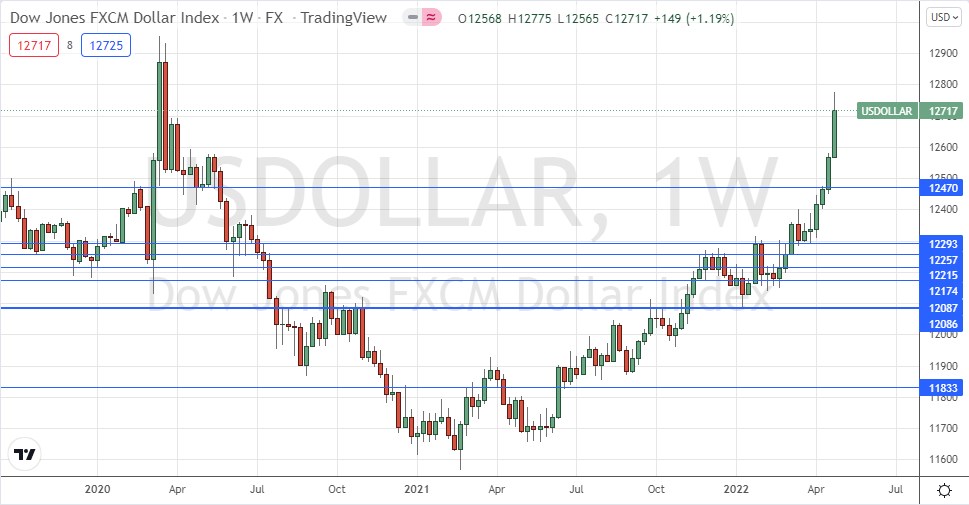 US Dollar Index Weekly Chart
US Dollar Index Weekly Chart
S&P 500 Index
The world’s most important stock market index, the S&P 500, fell again last week, closing well inside correction territory, and making its lowest weekly closing price seen in the past year. The weekly close was right on the low, a sign of significant bearish momentum. On the daily chart, the price is trading well below its 200-day and 50-day simple moving averages. These are bearish signs. Trading major stock market indices short is a difficult challenge, but experienced traders might want to be looking for short trades here. It is not a good time to be buying stocks.
I see the US stock market as affected by deteriorating consumer demand and a tightening monetary policy from the Federal Reserve.
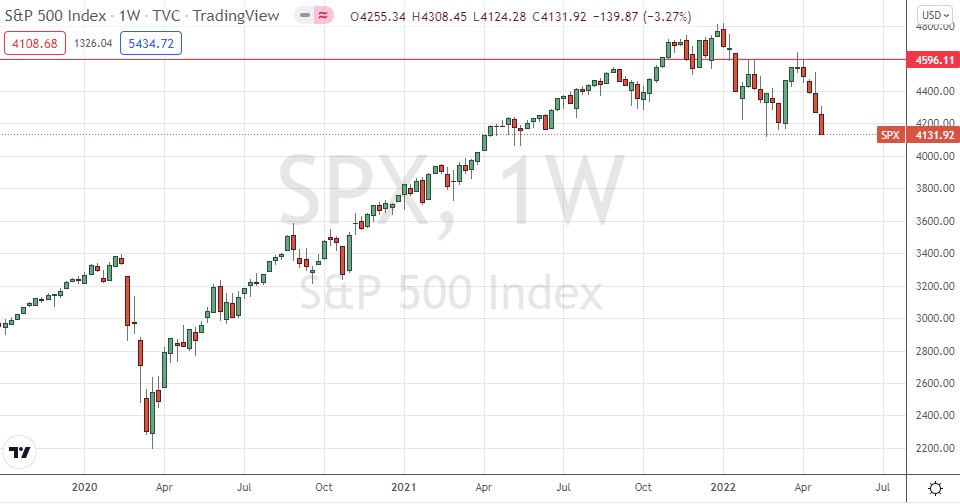 S&P 500 Index Weekly Chart
S&P 500 Index Weekly Chart
USD/JPY
The USD/JPY has risen like crazy over the past eight weeks, gaining each week. The past week saw the price rise again, peaking at ¥131.25, which is the highest price seen in 20 years.
Despite that weekly picture, the end of the week saw bullish momentum fall away. Although the Bank of Japan continue to talk up their expansionary monetary policy, the Bank has also expressed a view recently that ¥130.00 is as high as this currency pair should go.
As momentum has declined, and as the price has already exceeded ¥130.00, I only want to enter a new long trade in this currency pair if we see a daily (New York) close above ¥130.80.
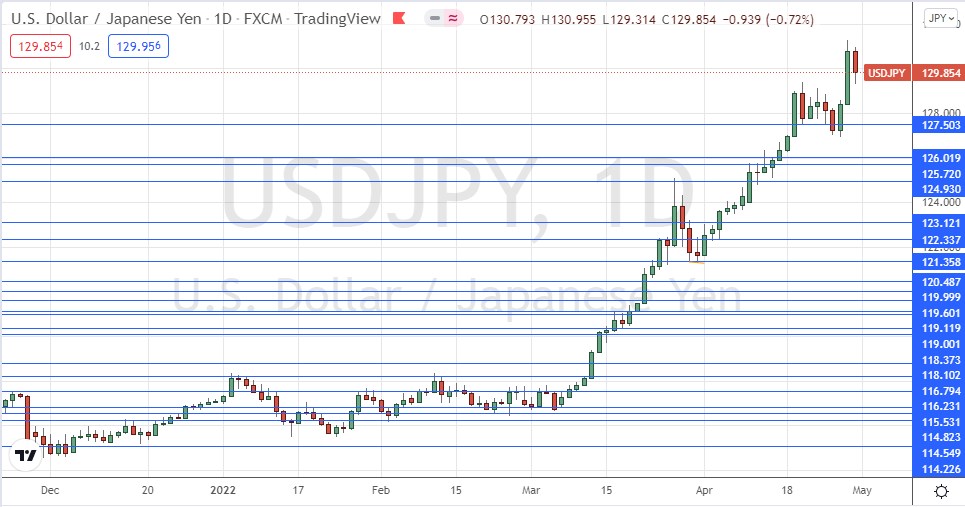 USD/JPY Daily Chart
USD/JPY Daily Chart
2-Year US Treasury Yield
There has been much focus on US treasury yields lately, after the yield curve briefly inverted a few weeks ago, and as the Fed and other major central banks begin to take significant steps to tighten monetary policy.
The US Dollar is the strongest major currency right now, and this is partly because the yields on its treasury bills have continued to reach new long-term highs not seen in 3 years.
Although the 10-year yield increased again last week, the 2-year yield again performed better than the 10-year, which is perhaps a good reason to be somewhat cautious about entering a new long trade in the 10-year, unless a new high is made. Trading the 2-year long might be a better approach.
Technically, we see what looks likely to be a nicely bullish inside bar in the weekly price chart below.
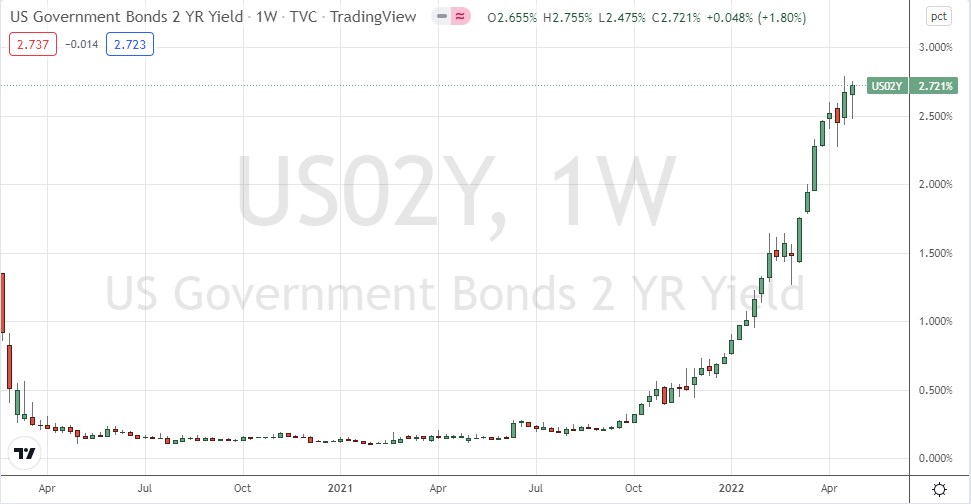
US 2-YR Government Bond Yield Weekly Price Chart
EUR/USD
The Euro, British Pound, and Swiss Franc fell sharply last week to reach new long-term lows against the US Dollar. The Dollar is strong but European currencies are showing standout weakness themselves, making these currency pairs the heart of the Forex market over the past week.
The fall in EUR/USD was unusually strong, and is the biggest weekly fall seen for many months. The price reached new 5-year lows and is not far from 18-year lows below that.
Although we saw strong bearish momentum with not much of a notable bullish retracement against it, bears may need to be cautious as we did see some evidence that $1.0500 may hold as support, getting in the way of further downwards movement.
I will be prepared to enter a new short trade if we get a daily (New York) close below $1.0498.
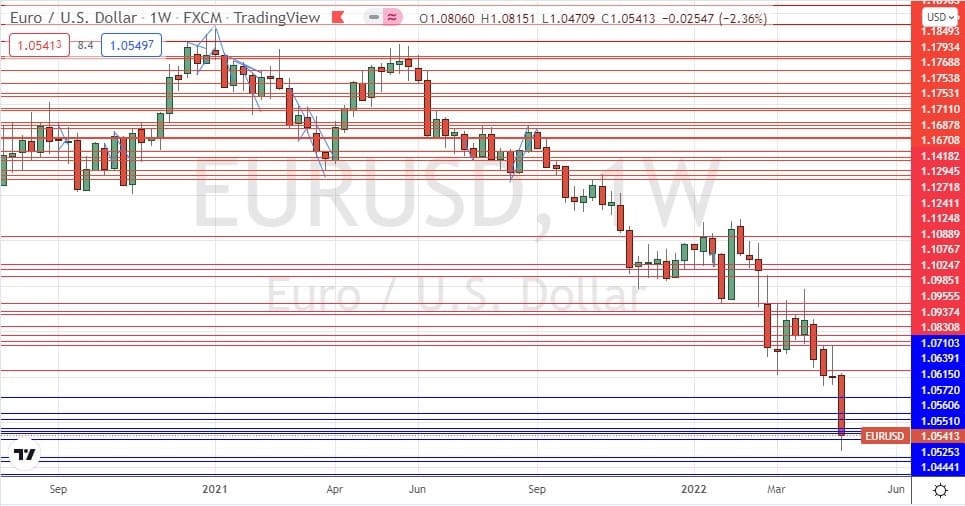
EUR/USD Weekly Chart
Bottom Line
I see the best opportunities in the financial markets this week as likely to be long of USD/JPY or short of EUR/USD, but only following respective daily (New York) closes above ¥130.80 and below $1.0498. I will also be prepared to go long on the 2-Year US Treasury Yield.

